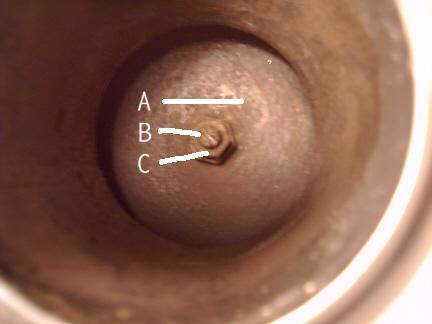|
This is NOT an obscene picture. Here, for what it is worth is a view of the inside of my aoogah horn. Sorry that I did not take pictures while I had it apart for painting. You are looking right in the hole in the front of the horn. |
| I only took mine apart to clean and paint
the outside. I could have adjusted it without taking it
apart. For the un-knowing, or un-caring, here is what I SHOULD have taken pictures of. The front and the back are held together with little bolts. The back is a plain old motor, and on the end of the shaft is a wheel, about the size of a 50 cent piece, with little V shaped bumps on the side away from the motor -- facing what would be the front of the car. There is a flat metal disk (A) sandwiched between two gaskets that is held between the front and the back of the horn. The gaskets crumbled when I took the horn apart, but I fashioned new ones from sheet gasket material from the local car supply store. What is happening is that the nut (C) serves as a lock nut, and the slotted screw (B) goes through the flat disc and has a pokey end on the back side. That screw adjusts the pokey end further or closer to the bumps on the wheel. So, as you hit the horn, the motor spins, rasping the V bumps against the pokey screw (B) and rattling the flat plate (A) to make the raspy sound. If the pokey screw goes in too far, it will strain the motor, or cause it not to spin at all. If it is too loose, the motor spins and the V bumps never even touch the screw, so no sound except a whirring of the motor. Trial and error will get the loudest sound. It was a bit tricky loosening the nut, and then adjusting the depth of the screw, and then tightening the nut to hold it in place. Short of taking it all apart and cleaning everything up, a shot of WD-40 might help. I used a long neck socket to loosen the holding nut, adjusted with a long screwdriver, and then TRIED to tighen the nut again. The screw wanted to move along with the set nut. No real solution there, other than to design a special long hollow socket that you can move while holding the screw still with a screwdriver run down the middle. MY solution was to over loosen the screw just the right amount so that when both the screw and the nut moved, they ended up in the right place. The nut must be re-tightened though, or it will just vibrate looser and looser. Good luck! |
|
| Alternative suggestion -- Bob, a Glassic admirer who owns a highly
modified "VW Thing" suggest the following: Unbolt the front bellows from the horn and remove it. At that point the gaskets and vibrating plate will fall out. Reassemble the horn - the back, the gasket, the vibrating plate, the other gasket -- but leave off the bellows part. Then you can reach the holding nut easily. Test the horn until you get the best sound, tighten the holding nut, and then take it apart again and reassemble WITH the bellows. |
|
| Feedback please. Is this too elementary, not clear, or what? | Don |
